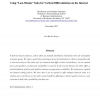Free Online Productivity Tools
i2Speak
i2Symbol
i2OCR
iTex2Img
iWeb2Print
iWeb2Shot
i2Type
iPdf2Split
iPdf2Merge
i2Bopomofo
i2Arabic
i2Style
i2Image
i2PDF
iLatex2Rtf
Sci2ools
HICSS
2010
IEEE
2010
IEEE
Using "Last-Minute" Sales for Vertical Differentiation on the Internet
In Internet based commerce, sellers often use multiple distribution channels for the sale of standard consumer goods. We study a model of second degree price discrimination in which a monopolist sells to risk-averse buyers. The seller uses two channels that differ in their risk attributes. In one channel prices and qualities are fixed and availability is assured. In the second channel, the seller offers a joint-distribution of prices and qualities and may not guarantee availability. We characterize optimal two-channel selling policies. We show that it can be optimal to offer multiple identical items in a random sale event. However, the seller cannot benefit by offering two distinct quality levels in a sale event that is held with a probability less than one. JEL Classifications: D42, L1
Biometrics | HICSS 2010 | Multiple Distribution Channels | Optimal Two-channel Selling | Seller | System Sciences |
| Added | 17 May 2010 |
| Updated | 17 May 2010 |
| Type | Conference |
| Year | 2010 |
| Where | HICSS |
| Authors | Ori Marom, Abraham Seidmann |
Comments (0)

